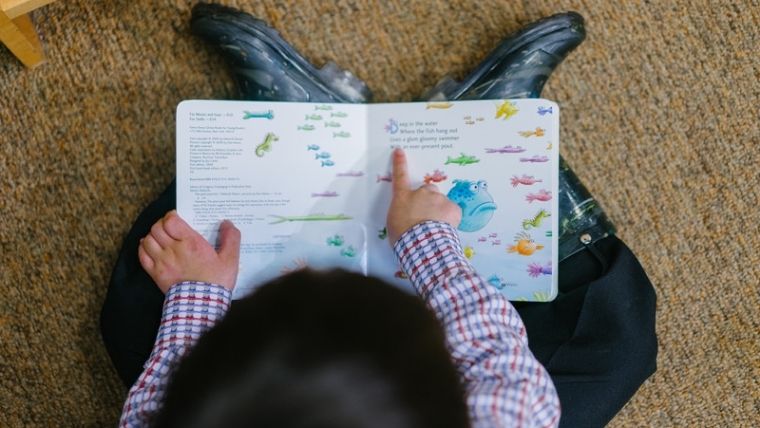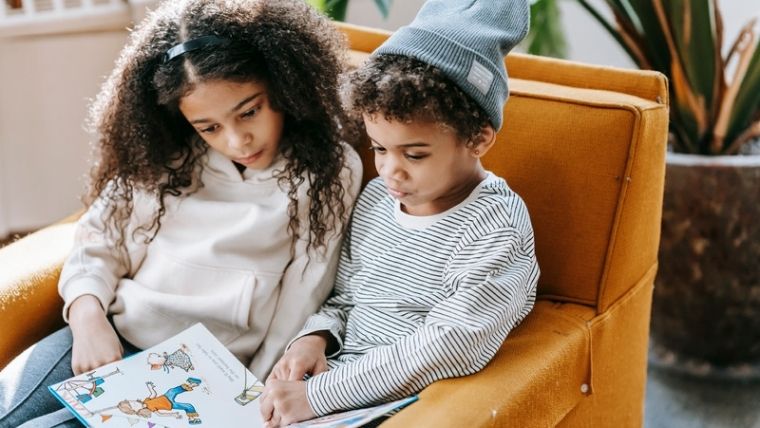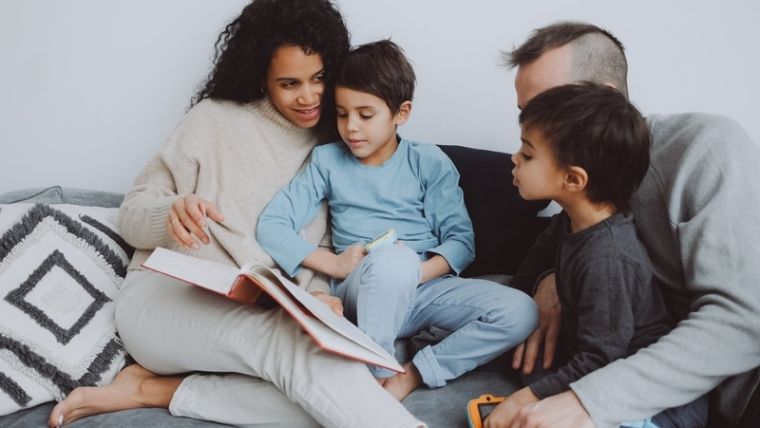Teaching kids to read is one of the most important and rewarding things you can do as a parent.
Study after study has shown that kids who learn to read from an early age will have a massive leg up on those who don’t.
Not only that, most schools are expecting kids to read from the earliest years.
Reading and strengthening language basis have been deemed really important, and the resulting upsurge in academic pressure is leaving more and more kids not being to perform well in the earliest years of education.
All kids have different learning cognitive preferences, and in a one-size-fits-all environment (i.e school), it can be challenging for kids to learn in a way that best fits their unique needs and personality.
For this reason, the problem of how to teach kids to read arises.
In the guide below, we’re going to discuss a number of tips, tools, resources (including reading apps like HOMER), and methodologies you can use as a parent or educator when teaching kids to read.
Why Is Teaching Kids to Read So Important?
Learning to read sets the foundation for lifelong learning.
Carol Anne St. George, EdD, an associate professor at the University of Rochester’s Warner School of Education, says that reading “helps grow [kids’] vocabulary and their understanding about the world…[and] leads to an increase in self-confidence and imagination.”
Some kids master reading by age of 6 to 7, while others improve significantly by the age bracket of 3 to 5. These help children in their brain development and improve concentration, by helping manage attention spans.
Moreover, reading also improves vocabulary and helps children articulate their thoughts, resulting in better oral and written communication. They start viewing the world with different perspectives if reading fiction and improve their knowledge base with non-fiction.
As a result, a regular reading habit boosts their self-confidence, and they are able to stand out.
When Do Kids Learn to Read?
There is no specific age uniform for every child on the planet. Some start by 3, others by 6 and some start until later in life when forced. It is a bad idea to overwhelm with all strategies and tactics to push them into reading, it will only repel them.
Kids only learn to read until they have a basic vocabulary developed. This is why, you should be asking them to narrate their stories from the day, ask them what they are doing, things they like and why, and so on.
Most kids aged 1 can respond when they are called out or spoken to and reach out for books. They can turn pages with some help and respond to stories and pictures by tapping their hands on some of them and by vocalizing.
They make noises to communicate what they are feeling. Toddlers up to 3 years of age can answer questions and understand the objects in the book. They can name pictures that look familiar and their favorite books.
Moreover, they pretend to be reading books and finish sentences of the stories they know very well. At this stage, you should help them point across the text of the book to develop a habit of reading
Up to the age of 5, kids can predict what may happen next in the story and read simple words in isolation. They can narrate the story and repeat it with the correct sequence. This is why, you should tell them a story and then in the end, as they summarize the happenings.
By the age of 7, they start reading and comprehending stories and use the context to understand newer words. They can tell the silent e, vowel teams like ai and oa, vowels controlled by the letter R, and more.
Around the age of 9, they may be able to read longer books without assistance, write notes, comprehend paragraphs, and use richer vocabulary in their own writings.
The key to being a good reader and improving reading level is to be consistent. Not only does it expand the vocabulary, it increases the knowledge and also the perspectives through which one can see the world.
The good news is that even if your child learns to read later than some of their peers, studies show kids who learn to read later often catch up to those who learned earlier. What’s important is that they learn to read period.
11 Tips For Teaching Kids To Read
1. Use Reading Apps to Make it Fun
 HOMER - The Essential Early Learning Program and App for Kids 2-8
HOMER - The Essential Early Learning Program and App for Kids 2-8
HOMER is a personalized learning app designed to help kids fall in love with learning. There are over 1,000 learning activities across all subjects, and the content is tailored to your child's age and interests.
These days, there’s an app for everything, and that includes teaching kids to read.
The best reading apps can help young kids master reading through fun games, interactive activities, and engaging lessons.
HOMER is one such app that focuses on a personalized interactive, adaptive learning program that helps them in boosting their confidence by climbing up the levels, and goals, respective to skill level, age, and interest.
HOMER is a playful platform that integrates the experience of playfulness with learning outcomes of reading, maths, creativity, thinking skills, and so on. This promotes children’s engagement with learning and they develop a passion for learning instead of feeling learning as a forced experience.
A wide variety in reading genre, hundred of different stories and characters from classics to favorites are provided by it. Moreover, there are additional resources that parents can access and look up to such as printables, videos, activities, and expert learning tips to improve their teaching skills.
That’s why HOMER is one of the best educational apps for kids and one of the top ways to start teaching kids reading.
HOMER pricing is very affordable at $9.99 a month or even less if you pay for a year in advance.
Click here to try Homer free for 30 days.
2. Use Songs And Nursery Rhymes
Children’s songs and rhymes are designed to hook up and engage children’s minds, which is quite creative and novelty seeking, to the present experience of learning, Those rhymes enhance the learning of kids by not limiting it to one senes i.e seeing or speaking.
As per research while teaching your kid to read or learn in general, involving more and more senses in learning something enhances the experience and makes it hard to lose what children have learned.
It is essential to develop your kids’ phonemic awareness and the best way to do so is to clap together and recite songs in unison. Performing bonding and involved activities with kids opens up them for learning on a mental and existential level, making it more likely for your kid to develop and learn what he or she is learning at a faster pace as compared to those learning methods that do not involve nursery rhymes and playful bonding with kids.
3. Make Simple Word Cards For Them
While teaching your kid to read, make a bunch of colorful cards each containing three sounds, preferably associated with that color. Invite your kid to choose a card they want, and show them a visual representation of those words in the book, internet, or some app.
Read the card together associating words with a visual representation of it. Hold up three fingers and ask them to read pointing to the visual representation of said words. After a few repetitions, read together words with them until they memorize and identify the right word with the right picture.
This sort of activity helps in building phonic learning capacity in them. Words cards activity requires preparation time, however, these are kinds of activities which parents can enjoy themselves as well, and play and learn with them like a kid.
Phonics and decoding skills are essential skills to build in kids to enhance their language and words pronunciation.
If your kids is just learning letters of the alphabet, teach them alphabets with this method. If they are at the level of learning sentences, make cards for short poems, and so on, respective to their learning level.
4. Engage Your Child In A Visual Learning Environment
Provide a print/ visual rich learning experience to your kids with respect to enhancing reading skills. Print out different visual word puzzles, phonics exercises, labels, animals and objects pictures, and so on to make their language learning on the go.
This enables connection and pattern making in kids’ minds, across different phonics, letter symbols, letter orders, objects, etc.
You should know that child’s mind is a mind of a genius, hence focusing on investing that unending curiosity in creative and critical things should be your goal as a parent.
When you go out or in some new environment, engage them with the physical environment around them with respect to what they learned previously in language and reading.
Point out focus to a specific word or alphabet and ask them ‘What sound is that letter?’,“What other word starts with that sound?” “What word rhymes with that word?” etc.
5. Play Word Games With Them
Connected to the last tip we have mentioned, introduce language and word spellings, puzzles, and games. Introduce games that involve listening, identifying, and manipulating the sounds of words.
For example, start with the questions like “What sound does the word XYZ start with?” “What sound does the word XYZ end with?” “What words start with the sound XYZ ?” and “What word rhymes with XYZ?”.
6. Understand The Core Skills Involved In Teaching Kids To Read
There are various skills that learning to read involves.
We are going to mention the top five components with respect to reading learning. In summary, these skills need to be targeted and included necessarily while teaching your kid to read and helping them overcome any reading difficulties they may be facing.
- Phonemic awareness
This ability involves hearing and manipulating the different sounds of words.
- Phonics
Learning the sound of alphabets and recognizing what sound two or more alphabets make when coming together. This, slowly, develops a pattern of combination of individual sounds, combined together and forming new phonics, in kids’ subconscious. This is how they learn reading.
- Vocabulary
Understanding, apparent, and contextual meaning, definitions, etc. understanding the meaning of words, their definitions, and their context.
- Reading comprehension
Understanding the apparent and implied meaning of stories and information books, which develops with the help of learning vocabulary first, then your kids learn the meaning and implication of one word with another.
- Fluency
The ability to read aloud with speed, accuracy & with understanding.
7. Play With Letter Magnets
Middle vowels sounds are the most tricky for kids to learn out of all. Hence different activities should be assigned to help kids learn this. Put magnet letters on the fridge, put vowels on one side. Say a word like ‘cat’ and ask your kid to spell it with the help of alphabets magnets.
8. Harness Fun Activities To Keep Your Child Engaged
Learning to read is an enjoyable activity for kids, but since they are kids, they are as equally quick to lose motivation as gain motivation. As a parent, it can be a challenge for you to motivate and engage your child if they hit a difficult wall and refuse to engage in the learning activity.
That’s why it’s so important that you understand how to make learning fun for your child.
For that, it is advised to use such apps and books, that have progressive criteria compatible with your children learning pace. It is necessary to be keen while teaching your kids to read, as it can be difficult to identify where exactly they are struggling with.
If there are loopholes in their basic skills, do not force your child to progress. It is best to go back and while teaching your kid to read to the basic skills such as phonics, alphabetic pronunciation, etc.
Moreover, use such resources and apps that have a reward mechanism that actually motivates and excites your child.
9. Read Together On A Daily Basis
A lot of parents do not understand the right placement of reading in kids’ brain, creative, and critical thinking skills development. At the earlier stage of development, the brain is growing physically till the age of 12 to 13.
Hence, it is necessary to provide such a learning environment that grows as many neurons of your kid as possible. Neurons are basically wires of the brain and it grows, spread out, and expand if the child is making a connection with and between different concept and things.
So, the basic purpose of reading is to enhance brain and brain neurons, and this is possible only by developing an abstract understanding of kids with help of reading.
Not just that, parents also can learn a lot of things in the process of teaching kids to read. Showing them how specific words sound can also build your logical thinking and pattern connecting skills.
10. Play Games To Memorise High-Frequency Sight Words Every Day
Pick up apps that allow for memorization of high-frequency sight words, through different interactive games, problem-solving puzzles, and repetition. Sights words are those that necessarily need to be recognized at sights.
Some high-frequency sight words are e.g. you, I, we, am, had, and, too, the, have, they, where, was, does). The strategy for that sight is “ See the word, say the word”.
Most people can learn most of those words at the age of 4 to 5. However, while teaching your kid to read, kids can be helped with learning sight words with apps and flashcards.
11. Develop Their Comprehension Skills
Alongside their early phonic reading books, your child will also be enjoying a range of longer and more complex stories and information books, which the teacher will share with the class or group.
These richer and more complex books give your child lots of opportunities to think about the story or information and share their ideas with other people.
Comprehension skills should also be focused on. One of the ways is to ask questions in different ways, so kids learn to connect things in more than one way, and develops a multi-perspective approach towards understanding things.
If your kid is young, ask questions that focus on identification, however for older kids ask questions that require the input of their opinion and moral judgment on a particular event and story.
5 Essential Components Of Reading You Need To Know
Reading is a skill that can be learned and acquired efficiently and quickly if the correct stages are followed. These five stages or components are phonics, phonemic awareness, vocabulary, fluency, and comprehension.
Phonics
These form the basic building blocks for reading the language. Kids are able to connect the symbols on the paper to the sounds. Even if the child can’t understand what the word means, they know how it sounds.
The ability to develop “reading by sight” is learned which results in reading fluency. They don’t have to stop and think of the letter instead they just voice it. To learn phonics, students can participate in the following activities:
- Rhyming Games help them categorize the words based on the ending sound
- Flexiwords help them break down words into phonemes
- Phonics Hopscotch get them to jump between different layers as heard by the tutor
- Guess the Word from a set of cards based on symbols
- Word Mix Up can help create multiple words from the same set of alphabets
Phonemic Awareness
Phonemic Awareness is when children understand how individual phonemes can be arranged into a set to sound differently and create different words. It develops an auditory understanding, as compared to thinking of words as symbols.
As opposed to other languages, like Japanese, English doesn’t have characters representing the syllables. This is why an awareness of phonemes is important to understand what the words mean.
This step is an early indicator of a student’s reading potential. To learn phonemic awareness, students can participate in the following activities:
- Phoneme Isolation to identify phonemes in a word
- Phoneme Identity to identify the common sound in different words, or rhyming sounds
- Phoneme Categories to find the odd one out from the category
- Phoneme Blending to blend multiple phonemes and develop a sound
- Phoneme Deletion to delete phonemes and understand what is left behind
Vocabulary
The range and multitude of words that help a child express in the language is the vocabulary. Vocabulary is not a skill that students can learn; it is the plethora of tools in a toolbox that they can use.
With better vocabulary, kids can read challenging books and understand unfamiliar material.
When they come across an unfamiliar word, they try to understand it by relating it to similar words or by making it out from the context. To improve their vocabulary, students can participate in the following activities:
- Word of the Day helps students learn a familiar word or phrase every day
- Creative Writing helps them develop a paragraph or an essay using ‘multiple words of the days’
- Class Glossary is a list of unfamiliar words to look up in a thesaurus and learn meanings
- Opposites Attract and also in games. They can pick cards and pair up with cards meaning the complete opposite
- Vocab Bookmarks in their current novel to write any new words they come across
Fluency
To read the language with speed and understand it, is fluency. Moreover, fluency is about ‘following’ the text and hearing the auditory expressions of words rather than just translating them.
Fluency is important since it helps read in a flow and to avoid being monotonous. Once a child is fluent, the next steps become easier to adopt. To be fluent, students can practice in the following ways:
- Teacher Modelling by reading aloud the perfectly fluent text
- Phrase Identification by taking a sentence and reading it aloud while students highlight phrases that are clubbed together, separated by pauses
- Choral Reading matches the flow in unison and help set the pace
- Paired Reading with one another encourages them to develop fluency and expression
- Using Audiobooks allows students to look up meaning and pronunciations on the go
Comprehension
Comprehending the text means answering the wh- questions: Who, What, When, and Where; and the How. Answering these questions helps understand the meaning of the text and be able to relate to it. Comprehension comes with practice, and students can practice by:
- Drawing a picture of a scene from the text
- Questioning the scenarios and prompting themselves to create alternative scenarios
- Reflecting over the text and thinking about the emotions evoked, analyzing the characters, and so on
- Connecting the dots from the story and relating it to their own lives
- Reading often as a habit
Mistakes to Avoid When Teaching Your Kids to Read
Some mistakes you should avoid when teaching kids to read are:
- Not reading out loud – Not reading out loud is a mistake you should avoid when teaching kids to read because they need to hear how each word sounds before they can attempt to read the words themselves.
- Reading too fast – Reading too fast is another mistake you shouldn’t make when teaching kids to read. When trying to help a kid learn how to read, the key is repetition. If they are trying to decode a word and you move on too quickly, how can they ever expect to learn?
- Giving up too soon – Teaching kids to read takes time and patience, so don’t give up too soon. Learning to read can take years, but it is a very important skill that they will use all their life.
- Not learning the fundamentals – Before teaching kids to read, it’s necessary to have them learn the fundamentals of reading first. These can include sounding out letters and blending sounds together, so before you try to do too much too soon, make sure they can master these more basic skills.
- Teaching to the test – When teaching kids to read, don’t teach to the test. Learning to read is an endeavor in itself, so it’s important for them to love reading and not see it as a chore or something your kid has to do.
- Making reading boring and not fun – Reading is supposed to be fun, so make sure you keep it fun! Don’t keep reading the same book over and over again because this is going to bore your young reader. Instead, try changing up books and finding ones they might be interested in more.
A Final Word on Teaching Reading to Kids
Teaching kids to read can be incredibly fun, exciting, and rewarding for everyone involved.
Instilling a love of reading into a child can give him or her an endless world of possibilities to discover and explore.
Remember, make it fun and be patient. Every child is different, and with time and consistency, things will fall into place.
Have any of your own tips for teaching kids to read? Share your thoughts by commenting below.




